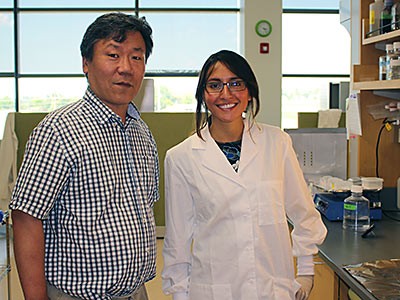How They Spent Summer Vacation: Doing Agricultural Research
Zane Davis, a molecular biologist at the USDA Poisonous Plant Research Lab on the USU campus, was paired with Tasha Azbill, a student studying natural resources and aquaculture at the College of Southern Idaho. They studied how different plants and soil types affect the uptake of toxic levels of selenium.
In the summer, the Utah State University campus is beautiful, but a little empty. It provides the perfect opportunity for out-of-town guests to experience all that Cache Valley has to offer, from hiking in the Rocky Mountains to working in the state-of-the-art research facilities on campus.
Nine students from a number of smaller colleges in Utah and surrounding states had the chance to live like Aggies as they spent 10 weeks participating in agricultural biotechnology research alongside faculty mentors at USU.
The Summer Undergraduate Agricultural Biotechnology Research Experience (SURE) program is 10-week program that places students in research laboratories with faculty mentors where they gain first-hand experience creating better varieties of crops, developing new biofuels, determining connections between nutrition and chronic diseases and participating in other agricultural- and biological-based research projects.
Funded by the United States Department of Agriculture, the SURE program is a chance for students to explore careers in scientific fields and get their foot in the door for future research opportunities, according to program co-director Chris Davies, research associate professor in the Department of Animal, Dairy and Veterinary Sciences.
“The SURE program gives students from non-research colleges the opportunity to get real lab experience,” Davies said. “With this program, we’re getting enthusiastic young scientists in the lab to help our faculty accomplish their research goals.”
An extra set of hands has been helpful for Zane Davis, a molecular biologist at the USDA Poisonous Plant Research Lab on the USU campus. Davis was paired with Tasha Azbill, a student studying natural resources and aquaculture at the College of Southern Idaho.
“Having Tasha around means we can work on another project and make more progress,” Davis said. “She’s doing all the same work I would be doing.”
Together, Davis and Azbill are studying how different plants and soil types affect the uptake of toxic levels of selenium. As mining companies leave old mining sites behind, they plant grass for livestock to graze on. However, certain plants will become toxic from the leftover shale and could potentially kill the grazing animals. Davis and Azbill are working to understand which plants will become toxic, providing useful information for farmers, mining companies and the forest service.
Azbill spends her days monitoring the growth of the plants, regulating the greenhouse temperature and checking water uptake.
“Before, I was undecided about what I wanted to do after I graduated,” Azbill said. “Now I know I would be really interested in doing research like this. And now I have the connections and the experience to make it happen.”
According to Jackie Bedoya-Wilkinson, a student from Ecuador studying microbiology at Weber State University, one of the most valuable aspects of participating in the program has been the chance to apply what she’s been learning in class to a real-world issue.
“I never thought I would be able to participate in undergraduate research,” Bedoya-Wilkinson said. “I didn’t even know how to get started. Now I get to use state-of-the-art equipment to work on important projects every day.”
Bedoya-Wilkinson works with Young-Min Lee, an associate professor in the Department of Animal, Dairy and Veterinary Sciences and researcher in molecular virology. Their work involves the Zika virus and other mosquito-borne viruses, with a focus on answering questions about the viral life cycle and discovering targets for antiviral therapeutics and vaccines.
“Zika virus research is a very urgent issue right now,” Lee said. “We are doing our best at USU to get closer to finding a vaccine. We need all hands on deck, and that’s why it’s great to have undergraduate researchers like Jackie to help out.”
During the program, the participants lived on campus and received a stipend for their work. The SURE program is set to continue for at least two more summers, and next year Davies hopes to expand it to include more undergraduate researchers.
“It’s so great to work with enthusiastic, engaged students who want to learn all they can about research,” Davies said. “I think the connections and the experiences that come from this unique program have a lot of potential to change students’ career objectives and opportunities.”
Related link:
USU College of Agriculture and Applied Sciences
Contact: Chris Davies, chris.davies@usu.edu
Writer: Shelby Ruud, shelby.ruud@usu.edu
PHOTO: AgResearch-Young-Min-Jackie_ust - Caption: USU faculty researcher Young-Min Lee mentored Jackie Bedoya-Wilkinson in the lab. Their work involves the Zika virus and other mosquito-borne viruses, with a focus on answering questions about the viral life cycle and discovering targets for antiviral therapeutics and vaccines.
TOPICS
Agriculture 225stories Hands-on Learning 211stories Plants 188stories Undergraduate Research 157stories Biotechnology 25storiesComments and questions regarding this article may be directed to the contact person listed on this page.








